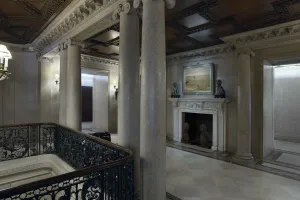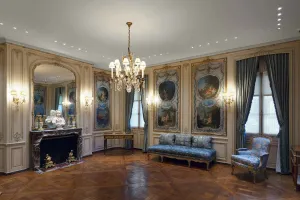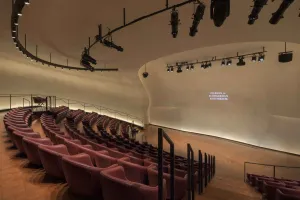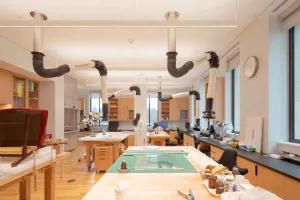Renovation and Enhancement Project
2021–2025
Overview
“The expansion is about as sensitive and deft as one could hope for. At moments...it approximates poetry...It moves the Frick squarely into the 21st century.”—The New York Times
For nearly ninety years, visitors from around the world have been deeply moved by the beauty and tranquility of The Frick Collection. To ensure the continued quality of the Frick experience, we undertook a newly completed renovation and enhancement project that enables us to better serve a twenty-first-century audience. Carried out with care and sensitivity, the project makes more of the 1914 Carrère and Hastings mansion accessible to the public. Critical updates to the buildings’ infrastructure allows us to provide the highest standard of care for the priceless collections they house, while the addition of new amenities and improved accessibility ensures an unparalleled experience for an international community of art lovers, students, and scholars.
To design the project, the Frick selected Selldorf Architects, a firm internationally recognized for its renovations and additions that honor a building’s original character. Selldorf partnered with executive architect Beyer Blinder Belle Architects & Planners, one of the country’s leading firms for historic preservation.
PROJECT GOALS
This project is the Frick’s first comprehensive renovation and upgrade since 1935. We have:
- Opened the mansion’s second floor to the public and created a dedicated space on the first floor for special exhibitions
- Created designated, state-of-the-art spaces for education, research, and public programs
- Added visitor amenities, including a café and an auditorium
- Updated critical infrastructure, including modernizing conservation studios
- Physically united the museum and the adjacent Frick Art Research Library to foster collaboration between visitors, scholars, and staff
- Improved ADA accessibility throughout the museum and library
- Cleaned and repaired our historic façades
- Restored the 70th Street Garden
New Gallery Spaces

The Second Floor
For the first time, the public may access the mansion’s second floor, which is especially well suited for the presentation of small-scale sculptures, ceramics, portrait medals, drawings, and paintings. Galleries on the second floor increase the museum’s display space for permanent collection objects by 25 percent, enabling visitors to enjoy more of the Frick’s art than ever before.

Ronald S. Lauder Exhibition Galleries
The Frick’s special exhibitions are acclaimed for their quality, originality, and intellectual rigor. A suite of three new galleries on the museum's first floor provides dedicated space for special exhibitions, allowing—for the first time—works from the permanent collection to remain on view alongside loaned objects, instead of being removed to temporary storage.

The Boucher Room
A highlight of the second floor is a gallery dedicated to a series of mid-eighteenth-century decorative panels by François Boucher and his workshop, which have been reinstalled in the room they occupied during Henry Clay Frick’s lifetime. This intimate space, overlooking Fifth Avenue and Central Park, also is used to display French furniture and Sèvres porcelain from the same period.
Public Program Facilities

Ian Wardropper Education Room
Community outreach is crucial to the Frick’s mission. For the first time, a dedicated education room addresses the needs of students and adult audiences by providing a flexible, multi-purpose space for courses, seminars, and programs. In order to streamline their visits, school groups now enter on East 71st Street, enjoy dedicated restrooms and coat-check facilities, and access the galleries via the new Evans Education Hall.

Stephen A. Schwarzman Auditorium
The Frick Collection’s celebrated holdings are complemented by a robust calendar of lectures, symposia, and concerts. The new, larger Stephen A. Schwarzman Auditorium better accommodates audiences, and state-of-the-art acoustics improve the sound quality of all programs. It has integrated assistive listening capabilities, recording facilities, and a livestream connection to the education room. In addition, a lobby and separate restroom facilities ensure ease of access and visitor comfort.

Designated Space for Library Activities
Since its founding in 1920, the Frick Art Research Library has been a leader in information science in the field of art history. Upgrades to the library’s facilities enable it to continue its pioneering efforts in the areas of digitization, born-digital resources, and digital art history. The project has restored the historic Reading Room by John Russell Pope, significantly upgraded conservation facilities (illustrated in the section below), and created new spaces for researchers to meet and collaborate.
Visitor Amenities

The project has added much-needed amenities that improve the visitor experience:
- The upgraded James S. and Barbara N. Reibel Reception Hall, with larger membership and ticketing desks, as well as an expanded coat-check facility on the lower level, ensures a smooth and comfortable arrival.
- A 50-seat café, a gift of the Margot and Jerry Bogert Family, provides a place for visitors and members to meet and enjoy food and refreshments, overlooking the 70th Street Garden.
- A more spacious, light-filled Museum Shop, a gift of The Selz Foundation, features an adjacent seating area, the Elizabeth M. and Jean-Marie R. Eveillard Hall, overlooking the restored 70th Street Garden.
- ADA-accessible entrance ramps and new elevators allow visitors to easily access the entire museum and library, including the second-floor galleries and the auditorium.
- ADA-accessible restrooms are available on multiple levels.
Caring for the Collection
Museum Conservation

The Frick’s sculptures and decorative arts receive preventive care, treatment, and technical study onsite. The new Sherman Fairchild Center for Art Conservation has dedicated workspaces, state-of-the-art equipment, natural light, running water, an exhaust system, and other necessary amenities in order to provide the highest caliber of care for objects in the permanent collection. For the first time, a purpose-built art elevator connects storage areas to the galleries and the conservation center, ensuring the safe and efficient transport of works of art.
Library Conservation

The Frick Art Research Library’s conservation studio is responsible for the preservation of a world-class collection of rare books, drawings, photographs, and archival materials. In close consultation with the curatorial team, the library’s conservators also treat prints and drawings from the museum’s permanent collection and works on paper loaned for special exhibitions. With high-efficiency, state-of-the-art equipment, the library’s new conservation studio has versatile workspaces where multiple treatments can be performed simultaneously. Its digital lab—which makes the library’s unique resources available online to scholars worldwide—also features improved facilities, including space for photographing oversized materials.
Connecting the Museum and Library

The Frick Art Research Library is housed in a landmarked building on East 71st Street, a block north of the museum. Uniting the museum and library enables visitors, scholars, and staff to move between the two branches of the institution, conveniently accessing the facilities and resources of both.
A modest addition has been built in the utility yard between the back of the library and the rear wall of the 70th Street Garden, creating passageways that unite the museum and library on multiple levels. Finished with Indiana limestone, the exterior façade complements the 1914 mansion, the 1935 addition, and the surrounding neighborhood and provides a refined backdrop for the adjacent garden, which was designed by Russell Page in the late 1970s and has been fully restored as part of the project.
Upgraded Infrastructure

The Frick’s historic buildings are more than a century old. Outdated and energy-inefficient infrastructure has been modernized to ensure the preservation of the house and library as well as their contents. The Frick is actively pursuing Leadership in Energy and Environmental Design (LEED) certification for achievements in improving sustainability and energy efficiency.
Infrastructure projects include the following:
- The 1914 mansion’s original steam heating and cooling systems have been replaced with state-of-the-art heating, cooling, and humidification systems that maintain museum-quality conditions while significantly improving energy efficiency.
- Outdated electrical wiring has been replaced.
- Antiquated skylights in the galleries have been replaced with ultraviolet-protected glass.
- The lighting throughout the museum, including historic fixtures, has been upgraded for improved visibility of artwork and greater energy efficiency.
- Waterproofing beneath the 70th Street Garden has been replaced.
- State-of-the-art sprinkler, fire alarm, security, and IT systems have been installed.
- Ramps at public entrances and seven interior elevators have been added to improve access to all public spaces, as well as back-of-house areas for employees.
Project Team

Annabelle Selldorf, FAIA, Principal
Selldorf Architects
Design Architects of The Frick Collection’s renovation and enhancement, Selldorf Architects is a 70-person architectural practice founded by Annabelle Selldorf in New York City in 1988. The firm has particular expertise in the complex requirements of cultural projects, having completed numerous museums, galleries, exhibition spaces, study centers, and artists’ studios. Past museum clients include the Museum of Contemporary Art San Diego, Smithsonian American Art Museum, Luma Arles, Clark Art Institute, and Neue Galerie New York. Currently, Selldorf is leading the renovation of the Sainsbury Wing and surrounding public realm at the National Gallery London, the Hirshhorn Museum and Sculpture Garden revitalization, and a 50,000-square-foot expansion of the Art Gallery of Ontario. The firm has also designed several galleries for David Zwirner and Hauser & Wirth, among others, and worked with the Frick on the design of its temporary Frick Madison installation.

Richard W. Southwick, FAIA, Partner, Director of Historic Preservation
Beyer Blinder Belle
Founded in 1968, Beyer Blinder Belle (BBB) is acclaimed for revitalizing some of America’s most iconic public buildings and cultural institutions including the Metropolitan Museum of Art, the U.S. Capitol, Grand Central Terminal, New York City Hall, the Ellis Island National Museum of Immigration, the Rubell Museum DC, the Empire State Building, Rockefeller Center, Cooper Hewitt-Smithsonian Design Museum, and the TWA Hotel at JFK International Airport. A comprehensive exploration of historic, cultural, and civic meaning guides the firm’s work, while its design is contemporary and reflects the materials and technologies of today. As executive architects for the Frick's renovation project, Beyer Blinder Belle provided project management and historic preservation expertise.
Project Consultants
Construction Manager
Sciame Construction, LLC
Project Management
The Frick Collection, Capital Projects Team
Colliers Project Leaders, Owner’s Representative
Engineering and Design Consultants
Kohler Ronan, LLC, Mechanical, Electrical, Plumbing, Fire Protection, Security, and IT Engineering
Arup, Façade, Windows & Skylights, and Theatre, Acoustics & AV
L’Observatoire International, Lighting Design
Loisos+Ubbelohde, Daylighting Design
Lynden B. Miller, Garden Designer and Preservationist
MPFP, Landscape Design
Samuel Anderson Architects, Objects and Book Conservation
Jenkins & Huntington, Inc., Vertical Transportation
Philip Habib & Associates, Civil Engineering
Langan Engineering, Geotechnical Engineering
Atelier Ten, Sustainability
WSP, LEED Administration
Guy Nordenson and Associates, Structural Consultant
Simpson Gumpertz & Heger, Structural Engineer of Record and Waterproofing
Clevenger Frable LaVallee, Inc., Food Service Design
Code Consultants, Inc., Code and Accessibility Consulting
Specialty Consultants
Pentagram, Graphic Design
AKRF, Environmental Analysis
Grounded Hospitality, Food & Beverage
Dharam Consulting, Cost Estimating
Radii Inc., Architectural Model Making
Walter B. Melvin Architects, Restoration Architects for the Exterior
West New York Restoration, Contractor for the Exterior Restoration
Seibold Security, Security Systems
Gallery Designers and Specialists
Stephen Saitas Designs, Exhibition Design
Glasbau Hahn, Casework Design and Fabrication
Traditional Line, Boucher Room Relocation and Restoration
EverGreene Architectural Arts, Interior Stone and Decorative Plaster Restoration
Aurora Lampworks, Inc., Historic Lighting Fixture Restoration
Steven Weintraub/Art Preservation Services, Daylighting Consultant and Picture Light Design and Fabrication
Anita Jorgensen Lighting Design, Gallery Lighting
Stark Carpet, Gallery Carpets
Artisans and Specialty Fabricators
Manufacture Prelle, Textiles
Passementerie Verrier, Passementerie
Couture for Homes, Wall and Furniture Upholstery and Window Treatments
Jean Carrau Decoration, Inc., Decorative Painting
Bricard Serrurerie d’Art, Architectural Hardware
P.E. Guerin, Architectural Hardware
Broome Lampshade, Inc., Lampshades
Costikyan, Inc., Historic Carpet Reproduction
Manhattan Shade & Associates, Window Shades
Seguso, Murano Glass Light Fixtures
Specialty Art Conservators and Installers
Art Conservation Group, Architectural Sculpture Conservation
Art Conservation Solutions, Architectural Painting Conservation
Melanie Brussat, Architectural Stone Conservation
Soraya Alcalá, Architectural Painting Conservation
Christine Daulton, Fresco Conservation
Shelley Greenspan, Textile Conservation
Giovanni Bucchi, Gilding Conservation
Susan Buck, Historic Paint Analysis
Cathedral of Saint John the Divine, Textile Conservation
Fine Art Services and Transport (FAST), Art Handling and Installation
Atelier Fine Art Services, Art Packing and Transportation
Crozier Fine Arts, Art Packing and Transportation
Mike Nixon/Odyssey Art Services, Art Rigging and Installation
Professional Services
Kramer Levin Naftalis & Frankel LLP, Land Use Attorney
Arnold & Porter LLP, Legal Services
Akerman LLP, Legal Services
DONATE
Join us for this exciting next chapter. Your gift to the Campaign for the Frick will help preserve the Frick experience for generations to come.
 Now Open
Now Open
The Frick Collection
 Now Open
Now Open
Frick Art Research Library
Image Credits
All renderings courtesy of Selldorf Architects
Post-renovation interiors, photos by Joseph Coscia Jr. and Nicholas Venezia
Workspace over the West Gallery during skylight replacement, photo by George Koelle
Annabelle Selldorf, photo by Stephen Kent Johnson, courtesy of Selldorf Architects
Richard W. Southwick, photo courtesy of Beyer Blinder Belle




